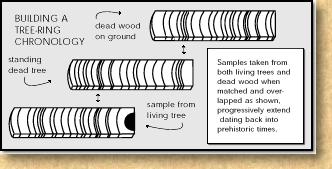
Part B: Chronometric dating:
CHRONOMETRIC DATING, also called Absolute Dating, makes use of methods that yield a date or date range for an object. Rather than just indicating if something is older or younger than something else, we get an actual time period as a result. Many of these methods use what is referred to as a 'molecular clock'. That is to say, a molecular process that happens at a regular and predictable rate.
CARBON 14 (C14) breaks down into nitrogen. It does so at a regular rate. The rate at which one element breaks down into another is referred to as the HALF LIFE of that element. The half life is the time it takes for half of the sample to break down. The half life of C14 is 5,730 years. So in a sample of C14, half of it will break down in 5,730 years. Then in another 5,730 years half of what is left will break down, and in another 5,730 half of that will break down, and so on.
C14 and C12 are present in the atmosphere and are absorbed by all living things while they are alive. Once a plant or animal dies, the C14 that is present in its body will start to break down into C12. Because we know the rate at which this happens, we can measure the ratio of C14 to C12 and determine the age of anything organic (bone, shell, wood, charcoal, plants, etc.). When we perform this test we get a specific date plus an error range. So the date will be stated, as say, 1145 years old + or - 50 years.
 |
The short half life of C14 allows us to use this method to date recent historic sites to sites that are 120,000 years old. This means we can use this method on anatomically modern human sites and on Neanderthal sites (Neaderthals survive until almost 28 thousand years ago.).
POTASSIUM /ARGON DATING works the same way. The half life of potassium, that is the time it takes half of a potassium sample to break down into argon gas, is 1.3 billion years. So we use this method to date much older sites. This method can be used to date sites that span our entire human evolution.
 |
Potassium/argon dating is performed on volcanic rock, rather than organic material. Potassium in the rock breaks down into argon gas, which is trapped inside the rock. We can then incinerate the rock to release and measure the argon gas. Again we will get a date with a range of error, say 3.6 million years + or- .05 million years. Uranium/Lead dating works much the same way. Refer to your text for a detailed description of this technique.
Other chronometric dating methods do not require a molecular clock. We can use DENDOCHRONOLOGY (tree ring dating) to get a specific year by counting the tree rings on a cut log. The date we get will be the date that that particular tree was cut down. However, if wood was recycled for subsequent building construction, the date we get will actually be earlier than the date the last building was constructed. Unlike the molecular dating methods, for dendochronology we get a single year date. Tree ring dating has also been used to confirm and calibrate carbon 14 dates.
 |
Tree rings are not simply counted, but rather, the patterns they make are compared to an established data base of tree ring patterns. Tree ring sequences are species and geographically dependent. That means, to use this method, we must have a known tree ring sequence for a particular species of tree in a particular climatic region. We cannot, for example get a date for a oak tree sample in California using a tree ring sequence for maple trees from Belgium.
Another limitation of Dendochronology is that sequences for various species that do exist only go back a limited number of years. They do go back up to 10,000 years in some areas, but this only covers recent sites related to our own species, Homo sapiens sapiens .
In the next several lectures we will see how these dating methods are applied to our evolution.
DEFINITIONS:
HALF LIFE
CARBON 14
POTASSIUM ARGON
DENDOCHRONOLOGY
REVIEW QUESTION:
How can tree ring dating be used to verify carbon 14 dates?
 |